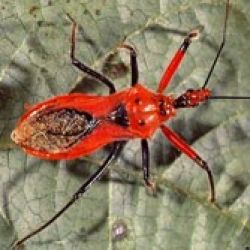Assassin bugs (Family Reduviidae)

Assassin bug adult
© J. Wessels, Queensland Government

Assassin bug nymph - colour can vary with age and species
© J. Wessels, Queensland Government

A raft of assassin bug eggs
© J. Wessels, Queensland Government

A large Australian assassin bug adult
© P. Grundy, Queensland Government

Assassin bug nymph
© J. Wessels, Queensland Government
Assassin bugs are common in Queensland and parts of New South Wales. They are generalist predators with large appetites.
Scientific name
Description
Adults are 10–30mm long and have:
- distinct, elongated heads with raised eyes
- long curved proboscises
- abdomens with a slight waist
- long, slender back legs
- enlarged front legs to grab prey.
Nymphs look similar to adults but don't have wings.
Eggs are:
- barrel-shaped
- laid upright in clusters or rows on leaves or stems.
May be confused with
- Brown bean bug
- Damsel bug
Distribution and habitat
Most common in tree crops. Also found in broadleaf crops such as cotton, pulses, canola and sunflower.
Hosts
Feeds on many different insects, but prefers soft-bodied prey such as caterpillars and small bugs like green mirids.
Impact on pests
Stabs its prey with stylet-like mouthparts and injects it with an enzyme that dissolves the inner organs. The liquid matter left is sucked out, leaving behind an empty shell.
Nymphs will eat up to 160 small to medium-size helicoverpa larvae in 9–12 weeks.
Life cycle and ecology
- Adults can lay up to 300 eggs in rafts (bundles) of 30–60.
- Eggs hatch within 2 weeks.
- Wingless nymphs pass through 5 growth stages before reaching adulthood.
- Adults may live for 6–10 months.
Factors that influence effectiveness
Research indicates that assassin bug nymphs have higher tolerance to some commonly used products than many other beneficials. Compatible insecticide options include NPV, spinosad, indoxacarb and pyriproxyfen.
Further information
In field evaluation of assassin bugs as biological control agents for cotton pest management (Project report)—Inside Cotton digital library